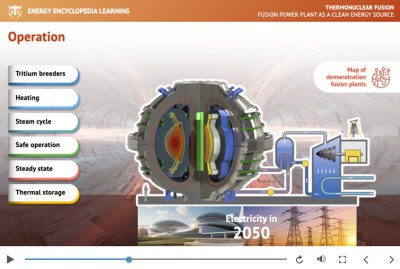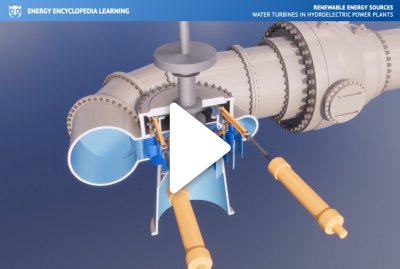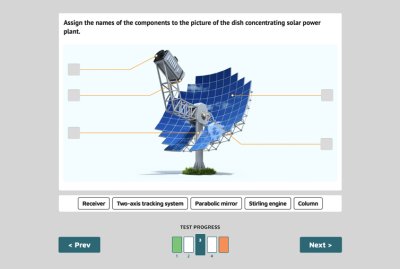
Learning
Nuclear Fusion Courses
How Does Thermonuclear Fusion Work?
Thermonuclear fusion powers the stars and produces 10 times more energy than fission. Mastering it in Earth conditions would provide an endless source of energy, but many technological challenges have yet to be solved.
Construction and Working Principle of Tokamaks
The tokamak uses a toroidal magnetic cage to isolate hot plasma from vessel walls. Thermonuclear fusion can be ignited inside after reaching suitable conditions. More than 50 tokamaks are involved in fusion research today.
Construction and Working Principle of Stellarator
The idea of a stellarator is based on the premise that plasma can be held in the reaction space by means of a special helically wound magnetic field that is generated exclusively by magnetic coils of various shapes.
Inertial Confinement Fusion
Inertial confinement tries to quickly compress the fusion fuel to achieve high temperatures and pressures. Typically, a hydrogen sphere is hit by laser beams directed at its surface or into a cavity called the hohlraum.
ITER — a Major Step Towards Thermonuclear Fusion
The ITER tokamak is a joint scientific project for fusion research. Inside the giant reactor, the fusion of hydrogen should release up to 500 MW of energy. The knowledge gained will be used to build a fusion power plant.
Fusion Power Plant as a Clean Energy Source
Thermonuclear fusion is a clean, safe and almost inexhaustible source of energy. Fusion plant could be based on magnetic or inertial confinement, use deuterium-tritium or aneutronic fusion, and produce own tritium fuel.
Nuclear Energy Courses
Radioisotopes as Sources of Ionizing Radiation
Ionising radiation is produced by the radioactive decay of unstable atomic nuclei called radioisotopes. It is everywhere around us, has different abilities to penetrate matter and various properties that we can exploit.
Interaction of Atomic Nuclei with Particles
Subatomic particles can interact with atomic nuclei when they come within range of strong nuclear forces. Neutrons, protons or other particles can bounce off, excite the atomic nucleus, enter the nucleus or cause fission.
Nuclear Fuel and the Nuclear Fuel Cycle
The nuclear fuel cycle begins with mining and processing the ore, enriching to the required concentration of fissile isotopes and producing fuel assemblies. Spent fuel is temporarily or permanently stored or reprocessed.
The Principles of Operating a Nuclear Power Plant
Nuclear power plant generates energy by fission of atomic nuclei in the reactor core. The reaction is controlled by a moderator and absorber. The heat is transferred to a steam turbine which converts it into electricity.
The First Reactor and the First Nuclear Power Plant
The first nuclear reactor was built by Enrico Fermi from graphite and uranium, and in 1942, he started the first controlled fission reaction. In 1951, the electricity from the first nuclear power plant lit four light bulbs.
The Most Used Nuclear Reactors: PWR and BWR
Most common types of nuclear reactors use ordinary water as a moderator and coolant. These are Pressurized Water Reactor that uses water under high pressure and Boiling Water Reactor in which water boils in the reactor vessel.
Sources, Processing, and Storage of Radioactive Waste
Radioactive waste is dangerous due to its negative effects on the biosphere and attention must be paid to the handling of it. Each type of radioactive waste requires a different system of storage and processing, as well as a different final storage in repositories.
Nuclear Power Plant Safety
Nuclear safety means the minimization of the possibility of a nuclear accident, whether due to a hardware malfunction or human error. The handling of nuclear material is under the control of the nuclear safety authority.
Renewable Energy Courses
Types of RES and the Use of Renewable
People have always used renewable energy sources, such as burning biomass to heat food, wind to propel ships, or water to power mills. Today, renewables are important for the transition to clean and sustainable energy.
Comparison of Renewable Energy Source
Renewable sources are clean, safe and easy to operate, but they have also low output density and a strong dependence on weather, location and season, which places certain demands on the electricity production from them.
Characteristics of Hydropower
Water energy is constantly renewed through the natural cycle and is used in hydroelectric power plants to drive turbines. Due to the diversity of river flows, there are many types of power plants, dams and turbines.
Water Turbines in Hydroelectric Power Plants
Water turbines are the main parts of hydroelectric power plants — an ecological renewable resource. Turbines have gone through a long period of development and today three main types are in use: the Francis, Kaplan, and Pelton turbines.
Wind Power Plants
Mankind has used the wind to propel ships, drive irrigation or grind grain since ancient times. Many types of turbines are used to convert wind energy into electricity. The most successful is horizontal axis lift turbine.
Solar Energy
The sun is a giant sphere of hot hydrogen at the centre of our solar system. Inside it, thermonuclear fusion takes place, releasing huge amounts of energy.

































































